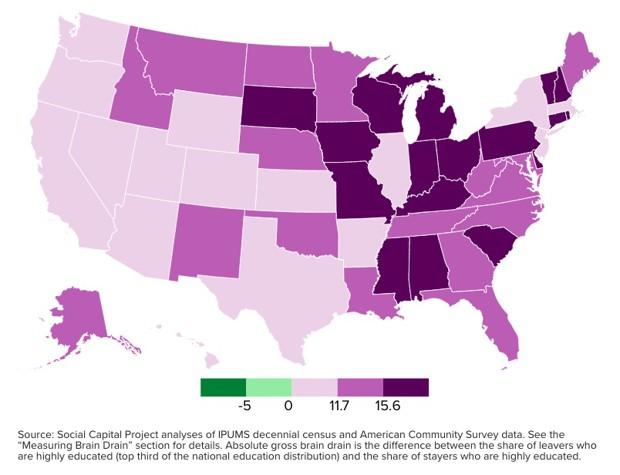As the United States navigates a rapidly changing economic environment and various societal hurdles, a troubling trend has surfaced: the departure of some of the nation’s most talented scientific professionals. In an arena marked by intense competition and evolving research priorities, numerous American scientists find themselves contemplating leaving their homeland in pursuit of more promising opportunities overseas. Business Insider investigates this escalating issue, sharing personal stories from researchers who have made this transition, analyzing the motivations behind their decisions, and considering the potential consequences for future innovation and scientific progress in America. With a workforce increasingly fragmented, one must ponder: what lies ahead for American science amid an unprecedented brain drain?
Evaluating Immigration Policy’s Role in Retaining Scientific Talent
The recent tightening of immigration regulations has significantly altered the landscape regarding scientific talent retention within the United States. Many researchers are now reassessing their futures in a country that once prided itself on being a hub of innovation and intellect. As visa restrictions grow more stringent, attracting and keeping top-tier talent becomes increasingly challenging; consequently, skilled scientists are exploring options abroad. The ramifications are clear:
- Brain Drain: A reverse migration trend where scientists leave the U.S. for more favorable conditions elsewhere.
- Loss of Innovation: A decline in groundbreaking research and technological advancements as talent exits.
- Cultural Shift: A less diverse scientific community that may lead to stagnation in perspectives and ideas.
Prominent institutions have reported a noticeable drop in applications from international scholars, raising alarms about the long-term viability of scientific research within U.S. borders. Recent surveys underscore this ongoing concern with alarming statistics:
| Year | Percentage of International Applicants |
|——|—————————————|
| 2020 | 45% |
| 2021 | 37% |
| 2022 | 30% |
Creative Approaches to Combat Research Exodus
The challenge posed by brain drain is significant for America’s scientific community; however, innovative solutions are emerging to counteract this trend effectively. Institutions are beginning to adopt flexible work arrangements that emphasize work-life balance—allowing researchers to tailor their schedules around personal commitments enhances job satisfaction while fostering creativity and productivity levels.
Moreover, establishing mentorship programs that connect seasoned scientists with early-career professionals can strengthen professional networks while providing essential guidance on navigating career paths effectively. By nurturing such supportive infrastructures within universities and research organizations, it becomes possible to retain invaluable talent.
Collaboration between academia and industry represents another promising strategy aimed at improving retention rates among scientists. Forming public-private partnerships can grant researchers access to funding sources as well as resources necessary for real-world applications related to their work—encouraging innovative projects while offering job security within competitive markets.
Additionally, providing competitive funding packages specifically designed for American researchers can alleviate financial burdens while incentivizing them to remain domestically based.
Strengthening Academia-Industry Collaboration for Growth
The migration of skilled individuals from American academic settings toward global opportunities highlights an urgent need to bridge gaps between academia and industry sectors effectively. As experienced researchers seek advancement beyond traditional tenured positions, institutions face unique opportunities to cultivate environments conducive to collaboration.
By aligning academic research objectives with practical industry needs through dynamic partnerships—such collaborations could take various forms including:
- Joint Research Initiatives: Collaborative efforts uniting academic experts with industry professionals focused on solving pressing real-world challenges.
- Internship Programs: Opportunities allowing students hands-on experience working alongside industry leaders while fostering new ideas.
- Knowledge Exchange Workshops: Events designed specifically for sharing information along best practices between academia & industries alike.
Furthermore enhancing collaboration may necessitate universities adapting curricula towards incorporating skills relevant directly applicable within today’s job market—establishing advisory boards featuring representatives from industries ensures academic programs stay aligned with current demands making graduates not only employable but also innovative thinkers ready tackle future challenges head-on!
The following table illustrates potential benefits arising from stronger ties between academia & industries:
| Benefits | Academia | Industry |
|————————|———————————–|————————————|
| Access To Funding | Increased availability grants | Investment into pioneering projects |
| Real World Insights | Enhanced relevance curriculum | Improved product development |
| Talent Development | Skilled graduates prepared | Future workforce aligned |
Final Thoughts
The issue surrounding brain drain within America has reached critical proportions—as evidenced by numerous experiences shared among scientists navigating these turbulent waters seeking better prospects abroad amidst challenging domestic conditions! The implications extend far beyond individual careers impacting overall innovation capabilities affecting future competitiveness nationally!
Policymakers alongside educational institutions & business leaders must recognize urgency surrounding this exodus considering strategic interventions aimed at retaining homegrown talents whilst attracting global expertise! Engaging dialogue addressing these pressing matters is paramount since it influences very fabric underpinning progress across all fields! Standing at crossroads today—the choices made will undoubtedly shape trajectory defining intellectual landscape generations yet unborn will inherit!
